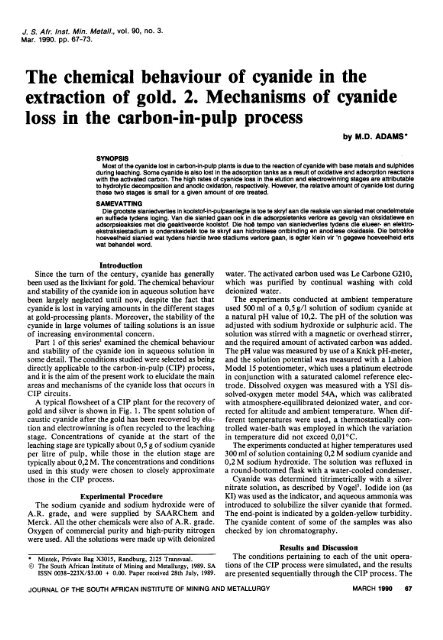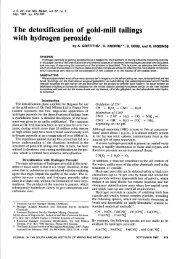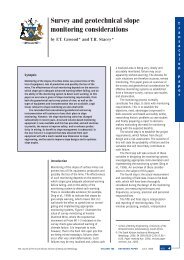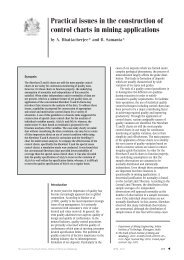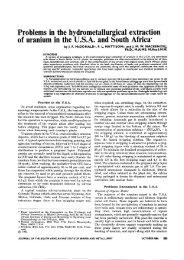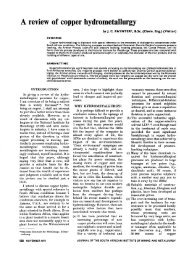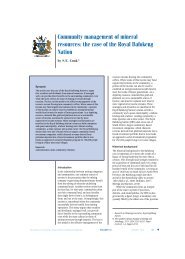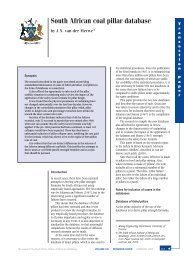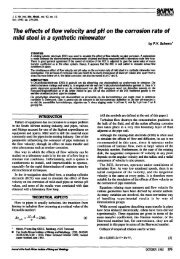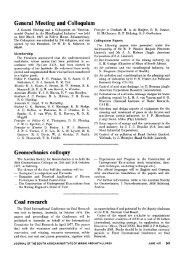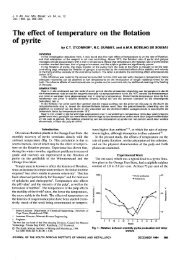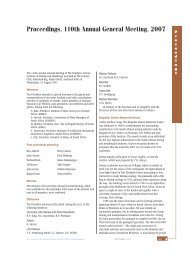The chemical behaviour of cyanide in the extraction of gold ... - saimm
The chemical behaviour of cyanide in the extraction of gold ... - saimm
The chemical behaviour of cyanide in the extraction of gold ... - saimm
You also want an ePaper? Increase the reach of your titles
YUMPU automatically turns print PDFs into web optimized ePapers that Google loves.
J. S. Mr. Inst. M<strong>in</strong>. Metal/., vo!. 90, no. 3.<br />
Mar. 1990. pp. 67-73.<br />
<strong>The</strong> <strong>chemical</strong> <strong>behaviour</strong> <strong>of</strong> <strong>cyanide</strong> <strong>in</strong> <strong>the</strong><br />
<strong>extraction</strong> <strong>of</strong> <strong>gold</strong>. 2. Mechanisms <strong>of</strong> <strong>cyanide</strong><br />
loss <strong>in</strong> <strong>the</strong> carbon-<strong>in</strong>-pulp process<br />
by M.D. ADAMS *<br />
SYNOPSIS<br />
Most <strong>of</strong> <strong>the</strong> <strong>cyanide</strong> lost <strong>in</strong> carbon-In-pulp plants is due to <strong>the</strong> reaction <strong>of</strong> <strong>cyanide</strong> with base metals and sulphides<br />
dur<strong>in</strong>g leach<strong>in</strong>g. Some <strong>cyanide</strong> is also lost <strong>in</strong> <strong>the</strong> adsorption tanks as a result <strong>of</strong> oxidative and adsorption reactions<br />
with <strong>the</strong> activated carbon. <strong>The</strong> high rates <strong>of</strong> <strong>cyanide</strong> loss <strong>in</strong> <strong>the</strong> elution and electrow<strong>in</strong>n<strong>in</strong>g stages are attributable<br />
to hydrolytic decomposition and anodic oxidation, respectively. However, <strong>the</strong> relative amount <strong>of</strong> <strong>cyanide</strong> lost dur<strong>in</strong>g<br />
<strong>the</strong>se two stages is small for a given amount <strong>of</strong> ore treated.<br />
SAMEV A TTING<br />
Die grootste sianiedverlies <strong>in</strong> koolst<strong>of</strong>-<strong>in</strong>-pulpaanlegte is toe te skryf aan die reaksie van sianied met onedelmetale<br />
en sulfiede tydens log<strong>in</strong>g. Van die sianied gaan ook <strong>in</strong> die adsorpsietenks verlore as gevolg van oksidatiewe en<br />
adsorpsieaksies met die geaktiveerde koolst<strong>of</strong>. Die h~ tempo van sianiedverlies tydens die eluear- en elektroekstraksiestadium<br />
is onderskeidelik toe te skryf aan hidrolitiese ontb<strong>in</strong>d<strong>in</strong>g en anodiese oksidasie. Die betrokke<br />
hoeveelheid sianied wat tydens hierdie twea stadiums verlore gaan, is egter kle<strong>in</strong> vir 'n gegewe hoeveelheid arts<br />
wat behandel word.<br />
Introduction<br />
S<strong>in</strong>ce <strong>the</strong> turn <strong>of</strong> <strong>the</strong> century, <strong>cyanide</strong> has generally<br />
been used as <strong>the</strong> lixiviant for <strong>gold</strong>. <strong>The</strong> <strong>chemical</strong> <strong>behaviour</strong><br />
and stability <strong>of</strong> <strong>the</strong> <strong>cyanide</strong> ion <strong>in</strong> aqueous solution have<br />
been largely neglected until now, despite <strong>the</strong> fact that<br />
<strong>cyanide</strong> is lost <strong>in</strong> vary<strong>in</strong>g amounts <strong>in</strong> <strong>the</strong> different stages<br />
at <strong>gold</strong>-process<strong>in</strong>g plants. Moreover, <strong>the</strong> stability <strong>of</strong> <strong>the</strong><br />
<strong>cyanide</strong> <strong>in</strong> large volumes <strong>of</strong> tail<strong>in</strong>g solutions is an issue<br />
<strong>of</strong> <strong>in</strong>creas<strong>in</strong>g environmental concern.<br />
Part 1 <strong>of</strong> this series I exam<strong>in</strong>ed <strong>the</strong> <strong>chemical</strong> <strong>behaviour</strong><br />
and stability <strong>of</strong> <strong>the</strong> <strong>cyanide</strong> ion <strong>in</strong> aqueous solution <strong>in</strong><br />
some detail. <strong>The</strong> conditions studied were selected as be<strong>in</strong>g<br />
directly applicable to <strong>the</strong> carbon-<strong>in</strong>-pulp (CIP) process,<br />
and it is <strong>the</strong> aim <strong>of</strong> <strong>the</strong> present work to elucidate <strong>the</strong> ma<strong>in</strong><br />
areas and mechanisms <strong>of</strong> <strong>the</strong> <strong>cyanide</strong> loss that occurs <strong>in</strong><br />
CIF circuits.<br />
A typical flowsheet <strong>of</strong> a CIF plant for <strong>the</strong> recovery <strong>of</strong><br />
<strong>gold</strong> and silver is shown <strong>in</strong> Fig. 1. <strong>The</strong> spent solution <strong>of</strong><br />
caustic <strong>cyanide</strong> after <strong>the</strong> <strong>gold</strong> has been recovered by elution<br />
and electrow<strong>in</strong>n<strong>in</strong>g is <strong>of</strong>ten recycled to <strong>the</strong> leach<strong>in</strong>g<br />
stage. Concentrations <strong>of</strong> <strong>cyanide</strong> at <strong>the</strong> start <strong>of</strong> <strong>the</strong><br />
leach<strong>in</strong>g stage are typically about 0,5 g <strong>of</strong> sodium <strong>cyanide</strong><br />
per litre <strong>of</strong> pulp, while those <strong>in</strong> <strong>the</strong> elution stage are<br />
typically about 0,2 M. <strong>The</strong> concentrations and conditions<br />
used <strong>in</strong> this study were chosen to closely approximate<br />
those <strong>in</strong> <strong>the</strong> CIF process.<br />
Experimental Procedure<br />
<strong>The</strong> sodium <strong>cyanide</strong> and sodium hydroxide were <strong>of</strong><br />
A.R. grade, and were supplied by SAARChem and<br />
Merck. All <strong>the</strong> o<strong>the</strong>r <strong>chemical</strong>s were also <strong>of</strong> A.R. grade.<br />
Oxygen <strong>of</strong> commercial purity and high-purity nitrogen<br />
were used. All <strong>the</strong> solutions were made up with deionized<br />
. M<strong>in</strong>tek, Private Bag X3015, Randburg, 2125 Transvaal.<br />
@ <strong>The</strong> South African Institute <strong>of</strong> M<strong>in</strong><strong>in</strong>g and Metallurgy, 1989. SA<br />
ISSN 0038-223X/$3.oo + 0.00. Paper received 28th July, 1989.<br />
water. <strong>The</strong> activated carbon used was Le Carbone 0210,<br />
which was purified by cont<strong>in</strong>ual wash<strong>in</strong>g with cold<br />
deionized water.<br />
<strong>The</strong> experiments conducted at ambient temperature<br />
used 500 ml <strong>of</strong> a 0,5 g/l solution <strong>of</strong> sodium <strong>cyanide</strong> at<br />
a natural pH value <strong>of</strong> 10,2. <strong>The</strong> pH <strong>of</strong> <strong>the</strong> solution was<br />
adjusted with sodium hydroxide or sulphuric acid. <strong>The</strong><br />
solution was stirred with a magnetic or overhead stirrer,<br />
and <strong>the</strong> required amount <strong>of</strong> activated carbon was added.<br />
<strong>The</strong> pH value was measured by use <strong>of</strong> a Knick pH-meter,<br />
and <strong>the</strong> solution potential was measured with a Labion<br />
Model 15 potentiometer, which uses a plat<strong>in</strong>um electrode<br />
<strong>in</strong> conjunction with a saturated calomel reference electrode.<br />
Dissolved oxygen was measured with a YSI dissolved-oxygen<br />
meter model 54A, which was calibrated<br />
with atmosphere-equilibrated deionized water, and corrected<br />
for altitude and ambient temperature. When different<br />
temperatures were used, a <strong>the</strong>rmostatically controlled<br />
water-bath was employed <strong>in</strong> which <strong>the</strong> variation<br />
<strong>in</strong> temperature did not exceed O,OI°C.<br />
<strong>The</strong> experiments conducted at higher temperatures used<br />
300 ml <strong>of</strong> solution conta<strong>in</strong><strong>in</strong>g 0,2 M sodium <strong>cyanide</strong> and<br />
0,2 M sodium hydroxide. <strong>The</strong> solution was refluxed <strong>in</strong><br />
a round-bottomed flask with a water-cooled condenser.<br />
Cyanide was determ<strong>in</strong>ed titrimetrically with a silver<br />
nitrate solution, as described by VogeP. Iodide ion (as<br />
KI) was used as <strong>the</strong> <strong>in</strong>dicator, and aqueous ammonia was<br />
<strong>in</strong>troduced to solubilize <strong>the</strong> silver <strong>cyanide</strong> that formed.<br />
<strong>The</strong> end-po<strong>in</strong>t is <strong>in</strong>dicated by a <strong>gold</strong>en-yellow turbidity.<br />
<strong>The</strong> <strong>cyanide</strong> content <strong>of</strong> some <strong>of</strong> <strong>the</strong> samples was also<br />
checked by ion chromatography.<br />
Results and Discussion<br />
<strong>The</strong> conditions perta<strong>in</strong><strong>in</strong>g to each <strong>of</strong> <strong>the</strong> unit operations<br />
<strong>of</strong> <strong>the</strong> CIF process were simulated, and <strong>the</strong> results<br />
are presented sequentially through <strong>the</strong> CIF process. <strong>The</strong><br />
JOURNAL OF THE SOUTH AFRICAN INSTITUTE OF MINING AND METALLURGY MARCH 1990 67
Ore<br />
Cyanide<br />
Loaded<br />
carbon<br />
Fig. 1-Typlcal flowsheet <strong>of</strong> a CIP plant<br />
for <strong>the</strong> recovery <strong>of</strong> <strong>gold</strong> and silver (after<br />
McDougall and Flem<strong>in</strong>g~<br />
Tail<strong>in</strong>gs<br />
to waste<br />
Cyanide<br />
Caustic<br />
Carbon<br />
p-<br />
--------------.<br />
Eluate<br />
Barren<br />
solution<br />
Gold and silver<br />
to<br />
ref<strong>in</strong>ery<br />
reaction rates and mechanisms are discussed <strong>in</strong> relation<br />
to <strong>the</strong> most important <strong>cyanide</strong> decomposition reactions<br />
that occur for each unit operation.<br />
Stability ojCyanide dur<strong>in</strong>g Leach<strong>in</strong>g<br />
<strong>The</strong> potential versus pH diagram for <strong>the</strong> Au-Hp-<br />
CN system is shown <strong>in</strong> Fig. 2. A comparison with <strong>the</strong><br />
diagram for <strong>the</strong> CN-H2O system (part 1 <strong>of</strong> this series,<br />
Fig. 1) shows that, under <strong>the</strong> conditions that are appropriate<br />
for <strong>the</strong> leach<strong>in</strong>g <strong>of</strong> <strong>gold</strong>, <strong>cyanide</strong> is <strong>the</strong>rmodynamically<br />
unstable, while cyanate is <strong>the</strong> more stable species.<br />
<strong>The</strong> k<strong>in</strong>etics <strong>of</strong> <strong>the</strong> oxidation <strong>of</strong> <strong>cyanide</strong> to cyanate are<br />
evidently extremely slow at room temperature under<br />
normal conditionsJ.S.<br />
Cyanide is consumed <strong>in</strong> <strong>the</strong> leach<strong>in</strong>g stage via <strong>the</strong> formation<br />
<strong>of</strong> metal-ion complexes such as Au(CN);,<br />
Fe(CN):- , and Co(CN)~-. In ores that conta<strong>in</strong> a large<br />
amount <strong>of</strong> iron or cobalt, six <strong>cyanide</strong> ions are consumed<br />
for every metal atom. This is unavoidable, and contributes<br />
to <strong>the</strong> loss <strong>of</strong> <strong>cyanide</strong> <strong>in</strong> <strong>the</strong> leach<strong>in</strong>g stage.<br />
When sulphur-bear<strong>in</strong>g m<strong>in</strong>erals are present, fur<strong>the</strong>r<br />
losses <strong>of</strong> <strong>cyanide</strong> are encountered as a result <strong>of</strong> <strong>the</strong> follow<strong>in</strong>g<br />
reactions:<br />
2 S2- + 2 CN- + °2 + 2 HP ~ 2 SCN-<br />
+ 4 OH-, (1)<br />
Sp~- + CN- ~ SCN- + S~-. "... (2)<br />
<strong>The</strong>se side reactions are <strong>the</strong> ma<strong>in</strong> cause <strong>of</strong> <strong>cyanide</strong> loss<br />
dur<strong>in</strong>g <strong>the</strong> leach<strong>in</strong>g <strong>of</strong> <strong>gold</strong>.<br />
Under typical leach<strong>in</strong>g conditions, only a slight loss <strong>of</strong><br />
<strong>cyanide</strong> due to its hydrolysis to hydrogen <strong>cyanide</strong> can be<br />
expected, and no measurable oxidation <strong>of</strong> <strong>cyanide</strong> to<br />
cyanate occursl.<br />
When conditions o<strong>the</strong>r than those normally employed<br />
dur<strong>in</strong>g leach<strong>in</strong>g are prevalent, an <strong>in</strong>crease <strong>in</strong> <strong>the</strong> consump-<br />
68 MARCH 1990 JOURNAL OF THE SOUTH AFRICAN INSTITUTE OF MINING AND METALLURGY
3,0<br />
AUO2<br />
:><br />
~<br />
] '-'-<br />
C ---- ---.<br />
"'00.<br />
I::<br />
,8<br />
U::s<br />
-\ID---<br />
-0<br />
po:<br />
"<br />
-.- ---"0-<br />
0 - '- --' '@-<br />
Au(CNh':------<br />
-'--. -.----<br />
@--.<br />
Au<br />
-'--- --, --.,<br />
0,6<br />
0,5<br />
.<br />
.<br />
0,4<br />
::::<br />
OD<br />
zu<br />
2:. "' 0,3<br />
0,2<br />
0,1<br />
..c<br />
u " E<br />
~ "::<br />
-<br />
QJ U<br />
.~<br />
I::<br />
"' ~<br />
~ ':;;<br />
I- ~<br />
. 8,0<br />
. 9,0<br />
le 10,2<br />
pH<br />
.12,5<br />
.14,0<br />
-10<br />
'0 2 4 6 8 10 12 14<br />
pH<br />
Reactions:<br />
a 2H20+2.-<br />
'" 20H- +H2 E= -0,0591 pH -0,0295 log PH2<br />
b 02+4H+ +40- 2H20 E~I,228 -0,0591 pH+O,O14710gp02<br />
'"<br />
3 AUO2+lf20+H+ +.- Au(OHh E=2,630 -0,0591 pH<br />
'"<br />
5 AU3+ +3H2O Au(OHh+3H+ pH= -J log [AU3+) -0,693<br />
'"<br />
9 Au(CNh- +.-<br />
Au+ +2CN- E=O,50+0,05910g [Au(CNh-]<br />
'" -0,118 log ([CN-].o'a! -2 [Au(CNh-))<br />
+O,11810g (4,93xlO-IO+[H+))<br />
10 Au(OHh+2CN- +2.- +3H+ '"<br />
Au(CNh- +3H20<br />
11 H202 02+2H+ +2.-<br />
'" P<br />
E~O,682 -0,0591 pH +0,0295 log [H2~2]<br />
12 HO2-<br />
02+H+ +2.-<br />
'" E~O,338 -0,0295 pH +0,0295<br />
P02<br />
[HO2-)<br />
Fig. 2-Homogeneous equilibrium diagram <strong>of</strong> potential versus<br />
pH for <strong>the</strong> Au-H2O-CN system at 25°C (after Flnkelsteln4)<br />
tion <strong>of</strong> <strong>cyanide</strong> can be expected. Changes <strong>in</strong> <strong>the</strong> pH <strong>of</strong><br />
<strong>the</strong> pulp have a marked effect, as is shown <strong>in</strong> Fig. 3.<br />
When <strong>the</strong> pH is lowered below <strong>the</strong> pKa <strong>of</strong> <strong>cyanide</strong><br />
(9,39), a large loss <strong>of</strong> <strong>cyanide</strong> can be expected dur<strong>in</strong>g a<br />
normal leach<strong>in</strong>g period <strong>of</strong> 20 hours.<br />
Temperature also has an effect on <strong>the</strong> loss <strong>of</strong> <strong>cyanide</strong>,<br />
as is shown <strong>in</strong> Fig. 4, and more <strong>cyanide</strong> will be lost as<br />
hydrogen <strong>cyanide</strong> on a hot day. <strong>The</strong> effect <strong>of</strong> air agitation<br />
over <strong>the</strong> typical 20-hour residence time is small, as<br />
shown <strong>in</strong> Fig. 5.<br />
Stability <strong>of</strong> Cyanide <strong>in</strong> <strong>the</strong> Carbon Adsorption Stage<br />
It was shown <strong>in</strong> <strong>the</strong> previous paper! that activated<br />
carbon acts as a catalyst for <strong>the</strong> oxidation <strong>of</strong> <strong>cyanide</strong> to<br />
cyanate. Moreover, evidence was cited for <strong>the</strong> adsorption,<br />
to some extent, <strong>of</strong> <strong>cyanide</strong> onto activated carbon.<br />
A relatively high loss <strong>of</strong> <strong>cyanide</strong> can <strong>the</strong>refore be expected<br />
<strong>in</strong> <strong>the</strong> adsorption tanks.<br />
<strong>The</strong> typical residence time <strong>in</strong> an adsorption tank is<br />
0<br />
0 10 20 30 40 50<br />
Time, h<br />
Conditions<br />
Volume <strong>of</strong> solution 500ml<br />
O2 <strong>in</strong> solution 6,5 mg/!<br />
Fig. 3-Effect <strong>of</strong> pH on <strong>the</strong> stability <strong>of</strong> <strong>cyanide</strong> at 20°C<br />
about 1 hour. Thus, for a six-stage adsorption circuit,<br />
<strong>the</strong> <strong>cyanide</strong> will be <strong>in</strong> contact with <strong>the</strong> activated carbon<br />
for about 6 hours. <strong>The</strong> effect <strong>of</strong> <strong>the</strong> concentration <strong>of</strong> carbon<br />
on <strong>the</strong> rate <strong>of</strong> <strong>cyanide</strong> loss is shown <strong>in</strong> Fig. 6. For<br />
a typical carbon concentration <strong>of</strong> about 25 g/l, <strong>the</strong> loss<br />
<strong>of</strong> <strong>cyanide</strong> is about 20 per cent over a 6-hour contact<br />
period. However, one-third <strong>of</strong> <strong>the</strong> <strong>cyanide</strong> can be lost if<br />
<strong>the</strong> concentration <strong>of</strong> carbon is <strong>in</strong>creased to 40 g/l.<br />
An even greater effect is evident when <strong>the</strong> pH value<br />
<strong>of</strong> <strong>the</strong> pulp drops, as shown <strong>in</strong> Fig. 7. <strong>The</strong> lower<strong>in</strong>g <strong>of</strong><br />
pH has been proposed6 as a means <strong>of</strong> improv<strong>in</strong>g <strong>the</strong> adsorption<br />
<strong>of</strong> <strong>gold</strong> onto carbon and, at <strong>the</strong> same time,<br />
achiev<strong>in</strong>g a low concentration <strong>of</strong> <strong>cyanide</strong> <strong>in</strong> <strong>the</strong> tail<strong>in</strong>gs.<br />
In a carbon-<strong>in</strong>-leach (CIL) situation, this would have to<br />
be carried out <strong>in</strong> <strong>the</strong> f<strong>in</strong>al adsorption stage only, s<strong>in</strong>ce<br />
a certa<strong>in</strong> nom<strong>in</strong>al concentration <strong>of</strong> <strong>cyanide</strong> is required<br />
to achieve efficient leach<strong>in</strong>g. <strong>The</strong> economic feasibility <strong>of</strong><br />
destroy<strong>in</strong>g <strong>the</strong> <strong>cyanide</strong> and enhanc<strong>in</strong>g <strong>the</strong> adsorption <strong>of</strong><br />
<strong>gold</strong> onto carbon by this technique has not been established.<br />
Stability <strong>of</strong> Cyanide dur<strong>in</strong>g Carbon Elution<br />
<strong>The</strong> odour <strong>of</strong> ammonia that exudes from <strong>the</strong> elution<br />
column <strong>in</strong> a CIP circuit is well known to operators, and<br />
sodium <strong>cyanide</strong> is sometimes added to <strong>the</strong> eluate <strong>in</strong> a<br />
Zadra process to replenish <strong>cyanide</strong> lost as a result <strong>of</strong><br />
decomposition. Operators at several plants <strong>in</strong> <strong>the</strong> USA,<br />
Canada, and Australia7 have reasoned that <strong>the</strong> presence<br />
<strong>of</strong> <strong>cyanide</strong> is not necessarily critical to <strong>the</strong> elution step<br />
<strong>in</strong> all cases, and <strong>the</strong>refore no longer use a caustic <strong>cyanide</strong><br />
eluant but, for example, employ caustic soda alone.<br />
JOURNAL OF THE SOUTH AFRICAN INSTITUTE OF MINING AND METALLURGY MARCH 1990 89
0,6<br />
0,5<br />
Temperature<br />
.. 5 °C<br />
)(<br />
20 °C<br />
. 30°C<br />
0,6 0 2,3 mg 02/1; N2 bubbl<strong>in</strong>g<br />
. 6,5 mg O2/1; No gas bubbl<strong>in</strong>g<br />
0,5<br />
-------<br />
0 15 mg O2/1; O2 bubbl<strong>in</strong>g<br />
.. > 20 mg 02/1; 02 bubbl<strong>in</strong>g<br />
--......-<br />
----...<br />
.. ..<br />
0,4<br />
~ 0,3<br />
zU t.s<br />
2:.<br />
0,2<br />
0,4<br />
::::::<br />
co<br />
~ 0,3<br />
t.s<br />
2:.<br />
0,2<br />
0<br />
0,1<br />
Q)<br />
..c::<br />
tJ e<br />
t.s .-<br />
Q) ....<br />
Q)<br />
-t.s tJ c::: Q)<br />
.:!<br />
~ f-o ~<br />
0<br />
0 10 20 30<br />
Time, h<br />
Conditions<br />
Volume <strong>of</strong> solution 500ml<br />
pH 10,2<br />
02 <strong>in</strong> solution 6,5 mg/I<br />
Fig. 4-Effect <strong>of</strong> temperature on <strong>the</strong> stability <strong>of</strong> <strong>cyanide</strong><br />
40<br />
0,1<br />
Q)<br />
tJ<br />
-t.s<br />
"5 e<br />
~ .;:<br />
c:::<br />
tJ Q)<br />
0. .-<br />
.- "0<br />
f-o<br />
» '" ~<br />
0<br />
50 0 10 20 30 40 50<br />
Time, h<br />
Conditions<br />
Volume <strong>of</strong> solution 500ml<br />
pH 10,2<br />
Fig. 5-Effect <strong>of</strong> <strong>the</strong> concentration <strong>of</strong> oxygen on<br />
<strong>the</strong> stability <strong>of</strong> <strong>cyanide</strong> at 20°C<br />
<strong>The</strong> actual extent <strong>of</strong> <strong>the</strong> decomposition <strong>of</strong> <strong>cyanide</strong> that<br />
is <strong>in</strong>herent <strong>in</strong> various elution procedures has not, as yet,<br />
been firmly established. Fig. 8 shows <strong>the</strong> results for <strong>the</strong><br />
loss <strong>of</strong> <strong>cyanide</strong> <strong>in</strong> <strong>the</strong> pre-treatment stage <strong>of</strong> an elution<br />
process developed by Anglo American Research Laboratories<br />
and known as <strong>the</strong> AARL process. A significant loss<br />
<strong>of</strong> <strong>cyanide</strong> is evident after 30 m<strong>in</strong>utes <strong>of</strong> pre-treatment,<br />
particularly at higher temperatures. (At l30°C, 80 to 90<br />
per cent <strong>of</strong> <strong>the</strong> <strong>cyanide</strong> has decomposed.) In fact, several<br />
processes have been reported9,1Ofor <strong>the</strong> destruction <strong>of</strong><br />
<strong>cyanide</strong> <strong>in</strong> aqueous waste solutions by <strong>the</strong>rmal decomposition<br />
techniques.<br />
<strong>The</strong> experiments used here differ from those used<br />
earlier <strong>in</strong> this work, <strong>in</strong> that <strong>the</strong> elution conditions were<br />
simulated. A typical solution was chosen, composed <strong>of</strong><br />
0,2 M sodium <strong>cyanide</strong> and 0,2 M sodium hydroxide, and<br />
hav<strong>in</strong>g a solution volume <strong>of</strong> 300 ml and a carbon concentration<br />
<strong>of</strong> 89 g/1. <strong>The</strong>se conditions are exactly <strong>the</strong> same<br />
as those used <strong>in</strong> previous work on <strong>the</strong> k<strong>in</strong>etics <strong>of</strong> <strong>the</strong> elution<br />
<strong>of</strong> <strong>gold</strong> from activated carbonll, and <strong>the</strong>y afford an<br />
easy comparison between <strong>the</strong> decomposition <strong>of</strong> <strong>cyanide</strong><br />
and <strong>the</strong> elution <strong>of</strong> <strong>gold</strong> under <strong>the</strong> same conditions.<br />
In <strong>the</strong> preced<strong>in</strong>g paper!, it was shown that <strong>the</strong> loss <strong>of</strong><br />
<strong>cyanide</strong> at 95°C, <strong>in</strong> both <strong>the</strong> presence and <strong>the</strong> absence<br />
<strong>of</strong> activated carbon, is due to <strong>the</strong> hydrolysis <strong>of</strong> <strong>cyanide</strong><br />
to ammonium<br />
formate:<br />
CN- + 2 HP - NH3 + HCO;. (3)<br />
<strong>The</strong> <strong>in</strong>stability <strong>of</strong> formate at higher temperatures<br />
<strong>in</strong> <strong>the</strong> follow<strong>in</strong>g overall reaction:<br />
results<br />
CN- + 3 HP - NH3 + CO2 + H2 + OH-. (4)<br />
Fig. 9 shows <strong>the</strong> dramatic effect <strong>of</strong> an <strong>in</strong>crease <strong>in</strong><br />
temperature from n to 95°C. At 95°C, about 93 per cent<br />
<strong>of</strong> <strong>the</strong> <strong>cyanide</strong> decomposed <strong>in</strong> 50 hours (<strong>the</strong> typical time<br />
taken for a Zadra elution at 95°C), whereas less than 30<br />
per cent was lost at noc over <strong>the</strong> same time period. Even<br />
if <strong>the</strong> actual residence time <strong>of</strong> <strong>the</strong> eluant <strong>in</strong> <strong>the</strong> column<br />
is taken to be half this <strong>in</strong> total, a loss <strong>of</strong> about 85 per<br />
cent <strong>of</strong> <strong>the</strong> <strong>cyanide</strong> can be expected. <strong>The</strong> use <strong>of</strong> a pressurized<br />
elution vessel will result <strong>in</strong> an even greater loss<br />
<strong>of</strong> <strong>cyanide</strong> (Fig. 8).<br />
<strong>The</strong> presence <strong>of</strong> activated carbon had little effect on<br />
<strong>the</strong> loss <strong>of</strong> <strong>cyanide</strong> at 95°C, except <strong>in</strong> <strong>the</strong> <strong>in</strong>itial stages,<br />
whereas at noc a marked <strong>in</strong>crease <strong>in</strong> <strong>the</strong> loss <strong>of</strong> <strong>cyanide</strong><br />
was evident with activated carbon.<br />
Despite <strong>the</strong> <strong>in</strong>crease <strong>in</strong> <strong>the</strong> rate <strong>of</strong> <strong>cyanide</strong> loss with an<br />
<strong>in</strong>crease <strong>in</strong> temperature, <strong>the</strong> actual amount <strong>of</strong> <strong>cyanide</strong><br />
consumed <strong>in</strong> <strong>the</strong> elution stage for a given amount <strong>of</strong> ore<br />
70 MARCH 1990 JOURNAL OF THE SOUTH AFRICAN INSTITUTE OF MINING AND METALLURGY
0,6<br />
0,5<br />
Carbon<br />
)C Og/l<br />
. 5g/1<br />
...25g/l<br />
.40 g/l<br />
0,6<br />
0,5<br />
pH<br />
~ 8,0<br />
. 9,0<br />
A 10,2<br />
10,9<br />
D 12,5<br />
014,0<br />
0,4<br />
0,4<br />
::::::<br />
bl)<br />
Z 0,3<br />
u t.s<br />
~<br />
0,2<br />
0,1<br />
Q)<br />
bl)<br />
t.s<br />
......<br />
'"§<br />
';::<br />
S<br />
';::<br />
Q)<br />
e-<br />
~ g<br />
-g<br />
-<br />
~<br />
'r;;<br />
t.s<br />
Q)<br />
u ....<br />
's. ;.,<br />
~<br />
::::::<br />
bl)<br />
Z 0,3<br />
u t.s<br />
~<br />
0,2<br />
0,1<br />
0<br />
0 10 20 30 40<br />
Time, h<br />
Conditions<br />
Volume <strong>of</strong> solution 500ml<br />
pH 10,2<br />
02 <strong>in</strong> solution 6,5 mg/l<br />
Fig. 6-Effect <strong>of</strong> <strong>the</strong> concentration <strong>of</strong> activated carbon on <strong>the</strong><br />
stability <strong>of</strong> <strong>cyanide</strong> at 20°C<br />
50<br />
0<br />
Fig. 7-Effect<br />
0 10 20 30 40 50<br />
Time,<br />
Conditions<br />
Volume <strong>of</strong> solution 500ml<br />
02 <strong>in</strong> solution 6,5 mg/l<br />
<strong>of</strong> pH on <strong>the</strong> stability <strong>of</strong> <strong>cyanide</strong> In <strong>the</strong> presence<br />
<strong>of</strong> activated carbon (25 g/l) at 20°C<br />
h<br />
~<br />
treated is less than that consumed dur<strong>in</strong>g <strong>the</strong> leach<strong>in</strong>g and<br />
adsorption stages. This occurs because much larger<br />
volumes <strong>of</strong> solution are <strong>in</strong>volved <strong>in</strong> <strong>the</strong> latter case. <strong>The</strong><br />
experience ga<strong>in</strong>ed by operators on CIF plants has been<br />
used to predict that <strong>the</strong> amount <strong>of</strong> <strong>cyanide</strong> consumed <strong>in</strong><br />
<strong>the</strong> elution stage can be expected to be roughly 10 to 20<br />
per cent <strong>of</strong> <strong>the</strong> amount consumed dur<strong>in</strong>g leach<strong>in</strong>g.<br />
Stability <strong>of</strong> Cyanide <strong>in</strong> <strong>the</strong> Electrow<strong>in</strong>n<strong>in</strong>g Stage<br />
An eluate from <strong>the</strong> elution <strong>of</strong> a loaded sample <strong>of</strong><br />
carbon from M<strong>in</strong>tek's pilot plant at Klo<strong>of</strong> Gold M<strong>in</strong>e was<br />
used <strong>in</strong> this experiment. This plant solution was chosen<br />
so that <strong>the</strong> effect <strong>of</strong> actual electrow<strong>in</strong>n<strong>in</strong>g conditions on<br />
<strong>the</strong> stability <strong>of</strong> <strong>cyanide</strong> could be determ<strong>in</strong>ed, <strong>the</strong> <strong>gold</strong>,<br />
silver, and base metal contents <strong>of</strong> <strong>the</strong> solution be<strong>in</strong>g sufficient<br />
for electrow<strong>in</strong>n<strong>in</strong>g to occur.<br />
<strong>The</strong> eluate consisted <strong>of</strong> <strong>the</strong> first three bed volumes <strong>of</strong><br />
an eluate from an AARL type <strong>of</strong> process. <strong>The</strong> pretreatment<br />
<strong>in</strong>volved a 30-m<strong>in</strong>ute pre-soak <strong>of</strong> <strong>the</strong> loaded<br />
carbon <strong>in</strong> a solution compris<strong>in</strong>g 2 per cent sodium<br />
hydroxide, 2 per cent sodium <strong>cyanide</strong>, 6 per cent ethanol,<br />
and 0,5 per cent methanol, followed by elution with<br />
deionized water.<br />
<strong>The</strong> electrow<strong>in</strong>n<strong>in</strong>g cell had an electrolyte capacity <strong>of</strong><br />
about 20 litres. <strong>The</strong> electrodes consisted <strong>of</strong> two titanium<br />
cathodes and three sta<strong>in</strong>less-steel anodes, all <strong>of</strong> which<br />
were 240 mm by 190 mm <strong>in</strong> size. <strong>The</strong> cell was filled with<br />
electrolyte, and raised to a temperature <strong>of</strong> 50°C. Electrolysis<br />
was <strong>the</strong>n applied to <strong>the</strong> cell at a voltage <strong>of</strong> 7 V and<br />
a current <strong>of</strong> 19 A. <strong>The</strong> concentration <strong>of</strong> <strong>cyanide</strong> <strong>in</strong> <strong>the</strong><br />
cell, as well as a control sample <strong>of</strong> <strong>the</strong> eluate kept at 50°C<br />
with no current pass<strong>in</strong>g through, are shown <strong>in</strong> Fig. 10.<br />
About 58 per cent <strong>of</strong> <strong>the</strong> <strong>cyanide</strong> had been lost from<br />
<strong>the</strong> solution <strong>in</strong> <strong>the</strong> electrow<strong>in</strong>n<strong>in</strong>g cell after 5 hours. In<br />
contrast, none <strong>of</strong> <strong>the</strong> <strong>cyanide</strong> <strong>in</strong> <strong>the</strong> control experiment<br />
was lost over <strong>the</strong> same period. (It had been found<br />
previously that 5 hours was a sufficient period <strong>in</strong> which<br />
to electrow<strong>in</strong> more than 95 per cent <strong>of</strong> <strong>the</strong> <strong>gold</strong>, and<br />
represents <strong>the</strong> typical electrow<strong>in</strong>n<strong>in</strong>g period for <strong>the</strong>se<br />
conditions.)<br />
This also has ramifications for <strong>the</strong> Zadra type <strong>of</strong> elution,<br />
and shows that a substantial loss <strong>of</strong> <strong>cyanide</strong> occurs<br />
due to hydrolysis, and due to catalytic oxidation <strong>in</strong> <strong>the</strong><br />
elution column and anodic oxidation <strong>in</strong> <strong>the</strong> electrow<strong>in</strong>-<br />
JOURNAL OF THE SOUTH AFRICAN INSTITUTE OF MINING AND METALLURGY MARCH 1990 71
I)<br />
..10:<br />
ci<br />
0<br />
oḌĊ
0,20<br />
0,18<br />
0,16<br />
.<br />
. Electrow<strong>in</strong>n<strong>in</strong>g<br />
. No electrow<strong>in</strong>n<strong>in</strong>g<br />
0,14<br />
" 0,12<br />
bI)<br />
Z<br />
U 0,10<br />
0:1<br />
~0,08<br />
0,06<br />
0,04<br />
0,02<br />
o<br />
o<br />
Flg.10-Rate<br />
2 3 4 5 6<br />
Time, h<br />
<strong>of</strong> oxidation <strong>of</strong> cy~nide Ina typical <strong>gold</strong>electrowlnnlng<br />
cell<br />
4. FINKELSTEIN,N.P. <strong>The</strong> chemistry <strong>of</strong> <strong>the</strong> <strong>extraction</strong> <strong>of</strong> <strong>gold</strong> from<br />
its ores. Gold metallurgy <strong>in</strong> South Africa. Adamson, R.J. (ed.).<br />
Johannesburg, Chamber <strong>of</strong> M<strong>in</strong>es <strong>of</strong> South Africa, 1972. pp.<br />
284-351.<br />
5. MORITZ,G. Electrolytic decomposition <strong>of</strong> <strong>cyanide</strong>s. Mod. Ytbehandl<strong>in</strong>g,<br />
vol. 9, no. 4. 1974. pp. 34-36.<br />
6. DAVIDSON,R.J. A pilot plant study on <strong>the</strong> effects <strong>of</strong> <strong>cyanide</strong> concentration<br />
on <strong>the</strong> CIP process. GOLD lOO.Proceed<strong>in</strong>gs <strong>of</strong> <strong>the</strong> International<br />
Conference on Gold. Fivaz, C.E., and K<strong>in</strong>g, R.P. (eds.).<br />
Johannesburg, South African Institute <strong>of</strong> M<strong>in</strong><strong>in</strong>g and Metallurgy,<br />
1986. vol. 2, pp. 209-223.<br />
7. ANON. Kidston Gold M<strong>in</strong>e. M<strong>in</strong>. Mag., voJ. 154. Jan. 1986. pp.<br />
16-21.<br />
8. DAVIDSON, R.J., and SCHMIDT, C.G. A review <strong>of</strong> <strong>the</strong> AARL process<br />
for <strong>the</strong> elution <strong>of</strong> <strong>gold</strong> from activated carbon. Proceed<strong>in</strong>gs <strong>of</strong><br />
<strong>the</strong> 15th CMMI Congress. Field<strong>in</strong>g, LE., and Gordon, A.R. (eds.).<br />
S<strong>in</strong>gapore, <strong>The</strong> Australasian Institute <strong>of</strong> M<strong>in</strong><strong>in</strong>g and Metallurgy,<br />
1986. vol. 4, pp. 215-225.<br />
9. ROBEY, H.L Cyanide destruction <strong>in</strong> a commercial-scale hydrolysis<br />
reactor. Plato Surf. F<strong>in</strong>ish., voJ. 70, no. 6, 1983. pp. 79-82.<br />
10. MOUSSAVI, M., and SUNDARAM, S.S. <strong>The</strong>rmal decomposition <strong>of</strong><br />
<strong>cyanide</strong> waste. Plato Surf. F<strong>in</strong>ish., vol. 69, no. 7: 1982. pp. 67-71.<br />
11. ADAMS, M.D., and NICOL, M.J. <strong>The</strong> k<strong>in</strong>etics <strong>of</strong> <strong>the</strong> elution <strong>of</strong> <strong>gold</strong><br />
from activated carbon. GOLD lOO. Proceed<strong>in</strong>gs <strong>of</strong> <strong>the</strong> International<br />
Conference on Gold. Fivaz, C.E., and K<strong>in</strong>g, R.P. (eds.). Johannesburg,<br />
South African Institute <strong>of</strong> M<strong>in</strong><strong>in</strong>g and Metallurgy, 1986.<br />
voJ. 2, pp. lll-121.<br />
JOURNAL OF THE SOUTH AFRICAN INSTITUTE OF MINING AND METALLURGY MARCH 1990 73


